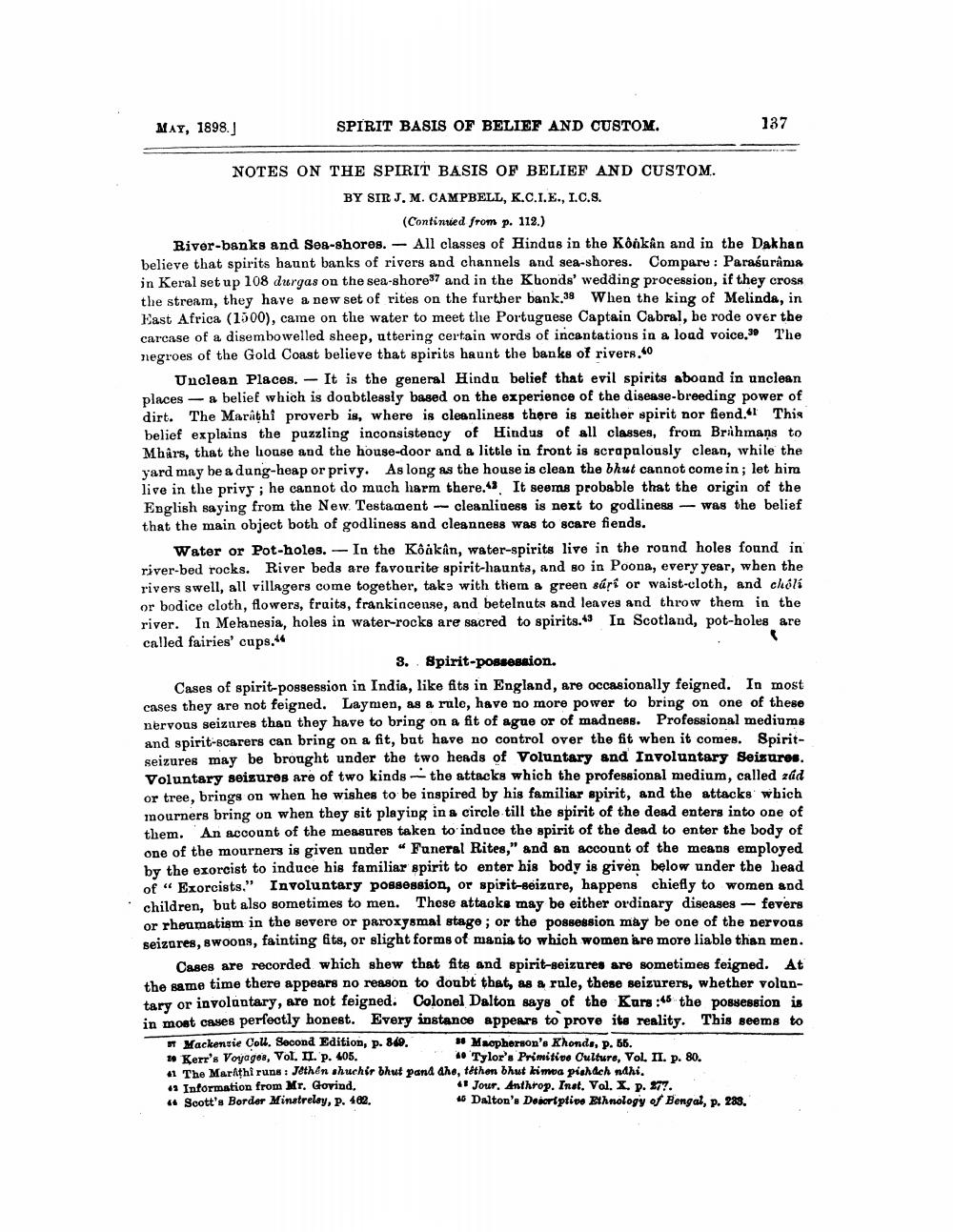________________
MAY, 1898.J
SPIRIT BASIS OF BELIEF AND CUSTOM.
NOTES ON THE SPIRIT BASIS OF BELIEF AND CUSTOM.
BY SIR J. M. CAMPBELL, K.C.I.E., I.C.S.
(Continued from p. 112.)
River-banks and Sea-shores. All classes of Hindus in the Kônkân and in the Dakhan believe that spirits haunt banks of rivers and channels and sea-shores. Compare: Parasurama in Keral set up 108 durgas on the sea-shore37 and in the Khonds' wedding procession, if they cross the stream, they have a new set of rites on the further bank.38 When the king of Melinda, in East Africa (1500), came on the water to meet the Portuguese Captain Cabral, be rode over the carcase of a disembowelled sheep, uttering certain words of incantations in a loud voice,30 The negroes of the Gold Coast believe that spirits haunt the banks of rivers.40
Unclean Places. It is the general Hindu belief that evil spirits abound in unclean places a belief which is doubtlessly based on the experience of the disease-breeding power of dirt. The Marathi proverb is, where is cleanliness there is neither spirit nor fiend. This belief explains the puzzling inconsistency of Hindus of all classes, from Brahmans to Mhars, that the house and the house-door and a little in front is scrapalously clean, while the yard may be a dung-heap or privy. As long as the house is clean the bhut cannot come in; let him live in the privy; he cannot do much harm there.43. It seems probable that the origin of the English saying from the New Testament cleanliness is next to godliness was the belief
that the main object both of godliness and cleanness was to scare fiends.
137
Water or Pot-holes. In the Kôåkân, water-spirits live in the round holes found in river-bed rocks. River beds are favourite spirit-haunts, and so in Poona, every year, when the rivers swell, all villagers come together, take with them a green súri or waist-cloth, and choli or bodice cloth, flowers, fruits, frankincense, and betelnuts and leaves and throw them in the river. In Melanesia, holes in water-rocks are sacred to spirits.43 In Scotland, pot-holes are called fairies' cups.44
—
3.
Spirit-possession.
Cases of spirit-possession in India, like fits in England, are occasionally feigned. In most cases they are not feigned. Laymen, as a rule, have no more power to bring on one of these nervous seizures than they have to bring on a fit of ague or of madness. Professional mediums and spirit-scarers can bring on a fit, but have no control over the fit when it comes. Spiritseizures may be brought under the two heads of Voluntary and Involuntary Seizures. Voluntary seizures are of two kinds the attacks which the professional medium, called zád or tree, brings on when he wishes to be inspired by his familiar spirit, and the attacks which mourners bring on when they sit playing in a circle till the spirit of the dead enters into one of them. An account of the measures taken to induce the spirit of the dead to enter the body of one of the mourners is given under "Funeral Rites," and an account of the means employed by the exorcist to induce his familiar spirit to enter his body is given below under the head of "Exorcists." Involuntary possession, or spirit-seizure, happens chiefly to women and children, but also sometimes to men. These attacks may be either ordinary diseases fevers or rheumatism in the severe or paroxysmal stage; or the possession may be one of the nervous seizures, swoons, fainting fits, or slight forms of mania to which women are more liable than men.
Cases are recorded which shew that fits and spirit-seizures are sometimes feigned. At the same time there appears no reason to doubt that, as a rule, these seizurers, whether voluntary or involuntary, are not feigned. Colonel Dalton says of the Kurs:45 the possession is in most cases perfectly honest. Every instance appears to prove its reality. This seems to ss Macpherson's Khonds, p. 55.
40 Tylor's Primitive Culture, Vol. II. p. 80.
Mackenzie Coll. Second Edition, p. 849.
1 Kerr's Voyages, Vol. II. p. 405.
41 The Marathi runs: Jéthén shuchir bhut pand dhe, têthen bhut kimea pishach nahi.
4 Jour. Anthrop. Inst. Vol. X. p. 277.
Dalton's Descriptive Ethnology of Bengal, p. 283.
42 Information from Mr. Govind, 44 Scott's Border Minstrelsy, p. 402.




